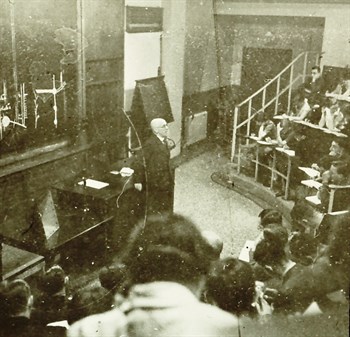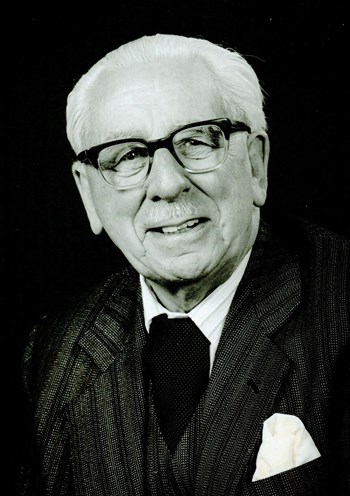During the academic year there are two named lectures in the main Society calendar. The Telford Memorial Lecture and the J F Wilkinson Memorial Lecture.
Professor Evelyn Davison Telford (1876-1961)
 Born in Middlesbrough on June 16th, 1876 and educated at Manchester Grammar School from where he obtained a scholarship at Caius College, Cambridge. He returned to the Old Infirmary for his clinical work at a time of great surgical interest. The first operation for acute appendicitis, the first closure of a perforated gastric ulcer, and the first gastroenterostomy dated from that time marking the hesitant fumbling change from antiseptic to aseptic technique.
Born in Middlesbrough on June 16th, 1876 and educated at Manchester Grammar School from where he obtained a scholarship at Caius College, Cambridge. He returned to the Old Infirmary for his clinical work at a time of great surgical interest. The first operation for acute appendicitis, the first closure of a perforated gastric ulcer, and the first gastroenterostomy dated from that time marking the hesitant fumbling change from antiseptic to aseptic technique.
He qualified in 1899 being head of the list in the Final examination at Cambridge, won his FRCS in 1903 and was eventually appointed to the Honorary Surgical staff at the Manchester Royal Infirmary in 1908 holding the post until his retirement in 1941. He was the first surgeon to open up S2 when the New Infirmary was brought into use in December 1908. He was a first class but conservative general surgeon, of the old school in some ways; surprisingly modern in others. He had a simple straightforward technique that avoided unnecessary cutting. He used remarkably few instruments. He was so meticulous that he appeared to be slow, but in fact he was a quick operator. His opinion on a case was always carefully weighed, concise and invariably correct.
He took great interest in children and for most of these years worked at various homes for crippled children. It was a great experience for his students to visit the wards at Swinton House Residential School to see something of this immensely valuable work. Keen students on his Unit were used as dressers, a privilege which happened no where else. His hour’s lecture invariable finished in forty minutes and was a clear, concise exposition of the subject. Some surgeons thought he over simplified but his words remained in the memory. He well merited election to the Chair of Systematic Surgery in 1922.
Telford made important contributions to surgery mainly on sympathectomy for thrombo-angiitis obliterans. His interest in crippled children led him to look into the question of the nervous control of blood vessels in the limbs in an endeavour to do something to improve the circulation in abnormally cold hands and feet. Working with Professor Stopford of the Anatomy Department they devised an operation for cutting the sympathetic nerve fibres. This allowed the affected arteries to dilate and bring more blood to the part, an operation that has been highly successful in warming cold limbs in young and old alike.
In addition he did original work on the prognostic value of spinal anaesthesia in vaso-spastic disease of the lower limbs and the thoracic inlet syndrome.
When he retired in 1941 the Infirmary lost one of its best surgeons, finest lecturers and most respected personalities. He was called back to help the hospital during the Second World War and finally retired in 1945. He was an authority on mezzotints and had a remarkable collection of Early English watercolours. As a gardener he specialised in auriculas. These and walking were his hobbies. He and his wife knew the Yorkshire dales, the hills of Derbyshire and the mountains of North Wales. He retired to Prestatyn and it was there he died on March 26th, 1961. His wife survived him a short time. In his will there was a munificent bequest to the Manchester Medical Society.
Dr John Frederick Wilkinson (1897-1998)
 Born in Manchester, he was one of the founders of haematology as a clinical speciality in Britain. He initially trained as a chemist, his undergraduate studies being interrupted by the First World War. Within a year of graduation he was a lecturer in medicine at the University of Manchester and Director of the new department of clinical investigation at Manchester Royal Infirmary. He held honorary posts at the Christie Hospital and Holt Radium Institute. He carried out much early research into pernicious anaemia and malignant blood diseases and was a pioneer of the use of nitrogen mustards in treating lymphomas and chronic leukaemia. He wrote many papers, was co-founder of the British Society of Haematology, a president of the European Haematology Society, and a life councillor of the International haematology Society.
Born in Manchester, he was one of the founders of haematology as a clinical speciality in Britain. He initially trained as a chemist, his undergraduate studies being interrupted by the First World War. Within a year of graduation he was a lecturer in medicine at the University of Manchester and Director of the new department of clinical investigation at Manchester Royal Infirmary. He held honorary posts at the Christie Hospital and Holt Radium Institute. He carried out much early research into pernicious anaemia and malignant blood diseases and was a pioneer of the use of nitrogen mustards in treating lymphomas and chronic leukaemia. He wrote many papers, was co-founder of the British Society of Haematology, a president of the European Haematology Society, and a life councillor of the International haematology Society.
He had a large private practice. On working days his Rolls-Royce would be parked outside his consulting wing adjacent to the private wing of the Royal Infirmary so that he had easy access to his hospital department, NHS wards, and private patients. He retired from the NHS in 1962, but patients were still being referred to him in his 90s.
Outside medicine his interests were scouting, animals (he was director and vice chairman of Chester Zoo), and old pharmacy jars, which are now housed in a special gallery in the Thackray Medical Museum in Leeds.
Dr John Frederick Wilkinson who died on the 13th August 1998, at the age of 101 served the Society as President in 1956 and served as Honorary Editor from 1956 onwards.